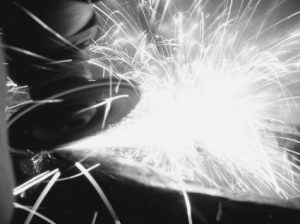A brake arcing machine manufacturer can be held accountable for toxic asbestos exposure to a mechanic, even though its product did not actually contain asbestos. 
These machines were used to grind asbestos-laden brake linings in auto mechanic shops throughout the country for decades.
Defendant in the California case of Rondon v. Hennessy Industries, Inc. argued that not only did its products not contain asbestos, but its machines were not designed to be used exclusively with products that contained asbestos. There was in fact ample evidence its machines were used on non-asbestos brake pads. It was based on this the trial court dismissed. But plaintiff appealed, and now the California Court of Appeal, First Appellate District, Division Four, has reversed, finding this “exclusive use” standard the defendant used should not have been used. The proper test was the “inevitable use” test, in which it is determined the machines would inevitably be used in a way that exposed workers to asbestos dust without adequate warning or protection.
According to court records, plaintiff developed mesothelioma after years of working as a mechanic and being exposed to asbestos dust while grinding brake linings. He alleged it was the brake arcing machines that actually released the dust into the air as he worked from 1965 to 1988. He alleged the manufacturer of these machines was liable under theories of both negligence and strict liability because, he argued, these machines had no other function than to grind these asbestos-filled brake linings.
In deciding to reverse the trial court’s grant of summary judgment to the defendant, the appellate court relied on a recent decision by the Second District Court of Appeal in Sherman v. Hennessey Industries, Inc.
Although manufacturers do have a duty to warn consumers about hazards that are apparent in their own products, this responsibility does not extend to hazard that arise form the products of other manufacturers. However, the court noted the plaintiff’s position was that it was not only foreseeable that defendant’s machines would be used to grind asbestos linings – this was their inevitable use. In reviewing whether a summary judgment is proper, the court has to view the facts in the light most favorable to plaintiff. So assuming this is true, the product was intended for the very activity that in fact created a dangerous situation. The company shoulders some of this responsibility for users’ asbestos exposure and later mesothelioma – even though its products didn’t actually contain asbestos – because its product substantially contributed to the harm.
In the Sherman case, this same defendant had argued it could not be liable as a matter of law unless plaintiffs could show the machine’s sole intended purpose was to grind asbestos brakes during the relevant time. However, defense argued, the machine was designed and used for the same action with non-asbestos brakes. Plaintiff in Sherman, however, noted that while non-asbestos brakes were available during the 1960s and 1970s, the almost universal majority of brakes contained asbestos. Even as late as 1986, approximately 95 percent of brake linings contained asbestos.
The Second District ruled that because the grinder contributed substantially to the harm, and a duty existed because the product inevitably created a hazardous situation.
That same logic was applied here in Rondon, which will now see the case proceed to trial.
If you or a loved one is diagnosed with mesothelioma in Boston, call for a free and confidential appointment at (617) 777-7777.
Additional Resources:
Rondon v. Hennessy Industries, Inc., June 16, 2016, California First Appellate District Division Four
More Blog Entries:
Asbestos Exposure and Mesothelioma in Military Veterans, June 12, 2016, Massachusetts Mesothelioma Lawyer Blog
 Mesothelioma Lawyers Blog
Mesothelioma Lawyers Blog

